Sentiment prediction from textual data
a textual data and sentiment technology, applied in the field of human sentiment prediction based on textual data, can solve the problems of often hampered emotional recognition systems and failure to meaningfully generalize beyond the few core terms explicitly considered in their construction
- Summary
- Abstract
- Description
- Claims
- Application Information
AI Technical Summary
Benefits of technology
Problems solved by technology
Method used
Image
Examples
Embodiment Construction
[0017]As provided herein, various methods, apparatuses and systems enable sentiment prediction from textual data. When an input text is received, embodiments described herein can determine a sentiment associated with the input text based on affective anchors in a space created through a training operation. Data, such as training texts, may be used to train a system to perform sentiment prediction. In at least some embodiments, a domain space provides a semantic representation of one or more identified areas of information. An identified area of information may be, for example, an area of broadcast news, email messages, iChat conversations, any customer support service (e.g., AppleCare provided by Apple Inc., Cupertino, Calif.), and any other area of interest. Each of the areas of interest can be further categorized into more discrete areas of interest. For example, a customer support service may be categorized into discrete areas associated with different products, customer concerns...
PUM
 Login to View More
Login to View More Abstract
Description
Claims
Application Information
 Login to View More
Login to View More - R&D
- Intellectual Property
- Life Sciences
- Materials
- Tech Scout
- Unparalleled Data Quality
- Higher Quality Content
- 60% Fewer Hallucinations
Browse by: Latest US Patents, China's latest patents, Technical Efficacy Thesaurus, Application Domain, Technology Topic, Popular Technical Reports.
© 2025 PatSnap. All rights reserved.Legal|Privacy policy|Modern Slavery Act Transparency Statement|Sitemap|About US| Contact US: help@patsnap.com



